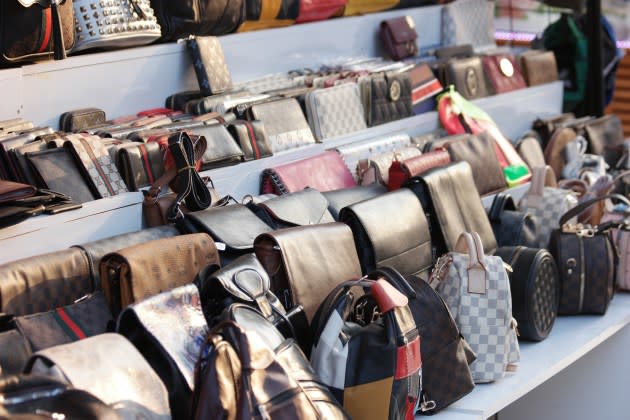Counterfeit Fashion: Understanding the Thin Line Between Knockoffs and Fakes

Last month, Damian Williams, the U.S. Attorney for the Southern District of New York, Ivan J. Arvelo, the Special Agent in Charge of the New York Field Office of Homeland Security Investigations. and Edward A. Caban, the commissioner of the New York City Police Department, announced the seizure of about 219,000 counterfeit bags, apparel, shoes and other luxury products.
Williams said the defendants used a Manhattan storage facility as a distribution center and described the seizure as the largest for counterfeit goods in U.S. history. The U.S. Patent and Trademark Office said as of 2018, “counterfeiting is the largest criminal enterprise in the world, with domestic and international sales of counterfeit and pirated goods totaling between an estimated $1.7 trillion and $4.5 trillion a year — a higher amount than either drugs or human trafficking.”
More from WWD
In the fashion apparel, footwear and luxury goods segment, retailers and brands work tirelessly to protect their brand, product and IP. Here, Megan Bannigan, a partner at Debevoise & Plimpton LLP, shares her observations about the recent seizure, the broader counterfeit market and what retailers and brands can do to mitigate the problem.
WWD: Can you explain the difference between knockoffs and counterfeit/fakes?
Megan Bannigan: The term “knock-off” is commonly used in the fashion industry. Its fashion speaks for imitation of another’s product or style. While knock-offs are ubiquitous, they are not always legal. A knock-off may copy features of another’s product but still be different enough that consumers are not confused about the source; it may copy enough from the other’s product that it causes some confusion, in which case it could be considered infringing, or it could identically copy another’s product “stitch-for-stitch” such that it could be considered a counterfeit.

In the U.S., while fashion design generally cannot be protected, certain elements of designs may be protected by intellectual property (e.g., design patents, trade dress or trademarks) and use of that IP by another may be infringing. For instance, specific fabric designs, surface designs or designs that are associated in consumer’s minds with a specific brand may be protectable. If those designs are copied — or “knocked off” — in a way that may cause substantial similarities or consumer confusion, they may be considered infringements. Similarly, copying a brand name or logo — or using one that is confusingly similar to another’s brand name or logo — may also be infringing.
“Counterfeit goods” are illegal knockoffs that imitate all aspects of the genuine product, including the genuine product’s name and design, and try to pass off as the original — in other words, a “replica” or “fake.” Unlike infringements, counterfeits are subject to both civil and criminal penalties and, in some circumstances, could pose increased dangers to consumers if they implicate health and safety.
WWD: Which categories tend to see the most knockoffs/fakes/counterfeits?
M.B.: The reality is that any good can be subject to counterfeiting. Knockoffs often appear when the “originals” are expensive or scarce. Some of the categories where we tend to see the most knockoffs and counterfeits are handbags and wallets, watches and jewelry, consumer electronics, apparel and accessories, medicines and personal care and footwear. As online purchases of cosmetics and beauty products have become more common, counterfeits have also been on the rise in the beauty industry.
WWD: How big is the fashion apparel and footwear counterfeit/fake market?
M.B.: It’s huge. Fakes and knockoffs, or “dupes” as Gen Z frequently calls them, have become a part of fashion culture, and counterfeit fashion apparel and footwear seizures are increasing. Just this year, the U.S. Attorney for the Southern District of New York and the Special Agent in Charge of the New York Field Office of Homeland Security Investigations announced the largest counterfeit goods seizure in U.S. history, consisting of 219,000 items of apparel, shoes and accessories with a total estimated manufacturer’s suggested retail price of approximately $1.03 billion.
One possible — and problematic — explanation for the proliferation of counterfeits in the fashion industry is the increased demand for counterfeit goods. Some consumers view fakes as a means of promoting accessibility and commenting on broader sociopolitical issues and even go so far as to seek out counterfeit goods. For example, the currently private “RepLadies” sub-Reddit is an online community with hundreds of thousands of members discussing and intentionally transacting in designer goods replicas, ranging from Birkin bags to Chanel flats to Cartier jewelry. Many online forums are dedicated to discussions of sneaker “replicas,” like the sub-Reddits r/Repsneakers and r/FashionReps.
WWD: How can retailers and brands mitigate IP infringement?
M.B.: Combatting the spread of counterfeits can be a monumental task. There are reactive and proactive approaches to mitigating infringement. One form of reactive mitigation is policing the internet for online listings of counterfeits. This approach, however, can quickly begin to feel like “whack-a-mole” as counterfeiters pop up in new locations, under new aliases and online storefronts.
By contrast, proactive steps may be more effective. There are a number of proactive steps retailers and brands can take to mitigate infringement. For example, brands can implement authenticity technologies at the product production stage to facilitate the identification of counterfeits later. This includes the use of solutions such as unique holograms (often integrated into packaging and labels), RFID technology, Near Field Communication tags, or QR codes that can be scanned to track a product’s “provenance” or journey through the supply chain. To more easily spot authentic goods, brands can incorporate digital watermarks visible only through use of special equipment, distinctive packaging that would show evidence of tampering, or other unique chemical or physical markets that would make their products distinctive and difficult to replicate.
There are also new technologies that may help mitigate infringement in other ways. For example, some brands are beginning to look to blockchain technology to better track genuine goods. Through a program called “Authentique,” brands like Burberry and Patou have worked with The Orde Group to create unique IDs for luxury goods, which can be based on nuanced details of a product’s textile or construction. Those digital IDs are then registered on the blockchain to facilitate tracking of genuine products. Brands can also implement AI technology to identify patterns in counterfeiters’ behavior, learn from the identification of counterfeits and equip themselves for more efficient anti-counterfeiting work in the future.
Another key step to mitigate infringement is to educate consumers. Some of the technologies discussed above can be deployed in ways that allow consumers to confirm the authenticity of products, avoiding unwitting or unintended counterfeit purchases. Brands like Ugg have provided online, educational resources that identify aspects of their products consumers should look for in spotting genuine, as opposed to counterfeit, goods. Ugg actually includes side-by-side photographs of genuine and counterfeit goods on its website.
WWD: Are authenticity technologies helpful? How does it work?
M.B.: Absolutely. While authenticity technologies may not perfectly root out all counterfeits, they are certainly helpful in minimizing counterfeiting sales. Authenticity technologies will vary depending on the products at issue, the context in which those products are sold and the resources available to the party applying those technologies. As an illustration, the authenticity technologies a brand itself can implement may vastly differ from those a resale marketplace or third-party seller can implement, solely based on the resources and information available to those respective parties.
Authenticity technologies can range from visual inspection and “look and feel” tests that compare the products at issue to genuine goods to technologies like those I mentioned above. Ultimately, the effectiveness of the various approaches will depend upon context and the exact technology being used. Still, some exciting prospects are out there to help combat these issues and protect consumers.
Best of WWD

